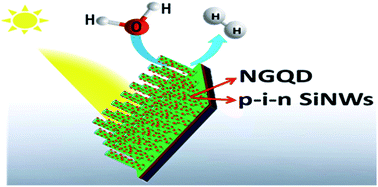p–i–n silicon nanowire array–NGQD: a metal-free electrocatalyst for the photoelectrochemical hydrogen evolution†
Abstract
Photoelectrochemical (PEC) water splitting is the most promising approach for the realization of efficient solar-to-fuel conversion. However, the biggest challenge is the development of efficient photoelectrodes with active, durable and inexpensive photocatalysts for the enhanced hydrogen evolution reaction (HER) kinetics. To date, pristine planar Si/metal-based devices have been featured as the most effective choice for the photoelectrochemical hydrogen evolution reaction (PEC-HER). Although this assembly has the advantage of prolonged stability, a major drawback remains in their higher production cost and ineffective light-trapping capabilities. These issues can be addressed by developing a metal-free, environment-friendly and corrosion-proof catalyst loaded on the large surface area of photoelectrodes to facilitate smooth charge transfer and enhanced light trapping properties. The present study reports the development of a vertically aligned p–i–n SiNWs electrode decorated with metal-free N-doped graphene quantum dots (NGQD), demonstrating a simplistic approach towards PEC-HER. The heterostructure shows excellent PEC-HER performance in terms of the low onset potential (−280 mV@1 mA cm−2), overpotential (−460 mV@10 mA cm−2) and the corresponding Tafel slope of 46 mV dec−1. Moreover, the Applied Bias Photon-to-current conversion Efficiency (ABPE) of the as-developed robust photocathode is ∼16.4%, which is higher as compared to most of the Si-based photocathodes. The catalyst also displays good stability of at least 6 hours at an applied current density of 10 mA cm−2 in acidic medium with a minimum (1%) loss of potential. Here, NGQD not only facilitates a low resistive path for the rapid electron transfer process, but also helps to accelerate the electrocatalytic HER kinetics on its surface. Remarkable properties, such as the enhanced absorption of incident light, easy separation, collection and the less recombination of charge carriers in the p–i–n SiNWs geometry, assist to boost the overall PEC performance. This study creates a new avenue to design a metal-free photocathode in the existing Si technology for an eco-friendly solar-to-hydrogen fuel conversion to cope with the present energy demand.



 Please wait while we load your content...
Please wait while we load your content...